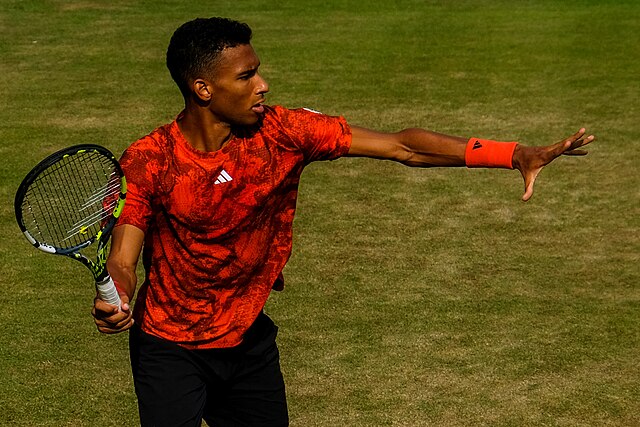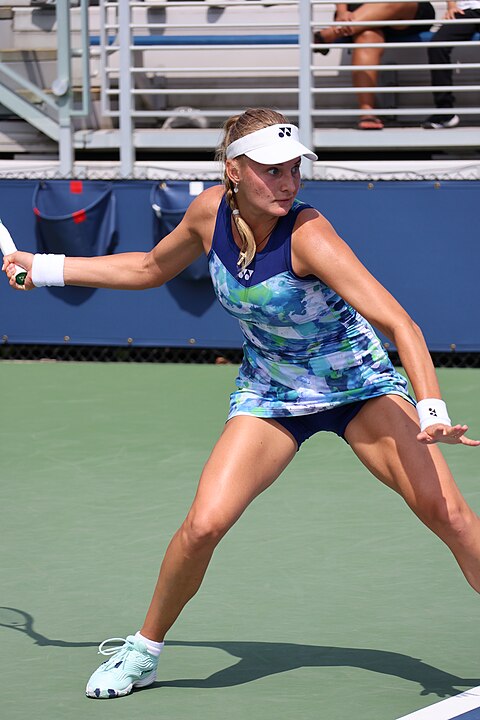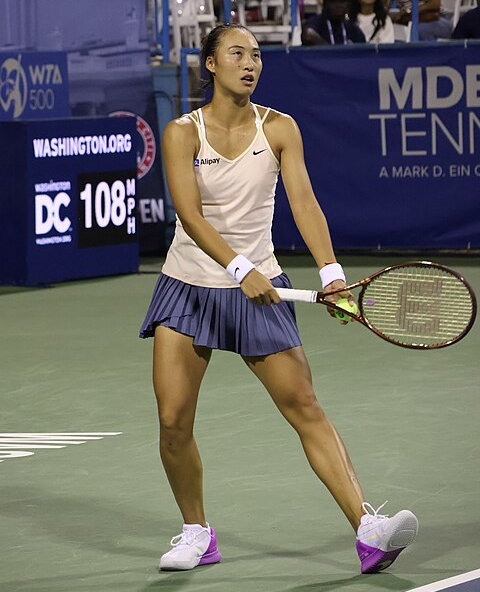Also today: February 8-10, 1974

There may not be a more beautiful serve in tennis. When Felix Auger-Aliassime is hitting his targets, returners don’t have a chance. Auger-Aliassime has been particularly deadly on indoor hard courts, winning four such championships in 2022, then defending his Basel title last October.
Before returning to the winner’s circle at the Swiss Indoors, the Canadian’s 2023 season was one to forget. He struggled with a knee injury that knocked him out of Lyon and most of the grass-court season, where he would otherwise have figured to thrive. Between Miami–where he last reached his career-best ATP ranking of 6th–and Tokyo, he won just two matches in a dozen starts. We can’t hold much of that against him; when it wasn’t the injury, it was the recovery or the rust.
But he hasn’t played like a top-tenner in 2024, either. He lost to Daniel Altmaier to open his campaign, got dragged into a five-hour slog by Dominic Thiem in Melbourne, and then fell yesterday in Marseille to Zhang Zhizhen. The Chinese man, who lost to 1,107th-ranked Sebastian Dominko in Davis Cup last weekend, isn’t the sort of player who should threaten the likes of Auger-Aliassime, especially on an indoor hard court. Marseille has a reputation as a relatively slow surface for an indoor event, but according to my numbers, it played almost exactly as fast as Basel did last year.
With such a serve, the rest of Felix’s game should fall into place. But it hasn’t, and even the Canadian’s service games can get messy. Zhang broke him three times in ten tries yesterday, and he came close to a fourth. Last week in Montpellier, Auger-Aliassime saved just one of six break points before squeaking past Arthur Cazaux. Apart from an occasional glut of double faults, the serve itself rarely fails him. He reliably sends in aces on at least one of ten service points. Nearly one-third of his serves don’t come back. So what’s the problem?
The Canadian charge
There’s a certain style of play that has become recognizably Canadian, by some combination of the influence of Milos Raonic and the natural development of players who grow up practicing indoors. While Auger-Aliassime, Denis Shapovalov, and Leylah Fernandez–like Raonic before them–rarely serve-and-volley, they often venture far inside the baseline after serving. The move puts them in excellent position to swat away weak replies, at the cost of getting exposed by a deep return.
(The move also calls to mind Evonne Goolagong, perhaps the most casual serve-and-volleyer in the game’s history. Martina Navratilova said of her, “She didn’t serve-and-volley; she would sort of saunter-and-volley.”)
If Felix’s aggressive court position pays off, it should show up in his second shot stats. This may sound familiar, because I talked about the same thing in my piece about Sebastian Korda earlier this week. Though Korda’s serve isn’t quite the weapon that Auger-Aliassime’s is, the two men are similar in that their overall results don’t seem to reflect the strength of their opening deliveries. Korda, for all of his power, hits a second-shot (plus-one) winner or forced error 17% of the time that a return comes back, almost exactly in line with tour average.
Auger-Aliassime is similarly punchless. I ran the numbers again, this time back to 2019 instead of 2020, to capture most of the Canadian’s career. The plus-one winner rates are a bit different, but not enough to alter the story. I’ve also included more players for comparison:
Player Plus-one winner% Milos Raonic 24.4% Denis Shapovalov 21.5% Matteo Berrettini 19.5% Carlos Alcaraz 19.1% Holger Rune 18.6% Lorenzo Sonego 18.4% Stefanos Tsitsipas 18.2% Felix Auger-Aliassime 17.6% Sebastian Korda 17.3% -- Average -- 17.2% Jannik Sinner 16.8% Daniil Medvedev 16.3%
Given the potency of his serve and the positioning risks he takes, Auger-Aliassime finds himself in the wrong section of this list. He’s not as one-dimensional as Raonic, and he’s less explosive (and erratic) than Shapovalov, but couldn’t he play more like Berrettini? You might argue that Felix’s ground game is better than the Italian’s, and he can thrive without forcing the issue so quickly. That may be true–I believe the Canadian and his team think this way–but the numbers don’t bear it out.
Over their careers, Auger-Aliassime and Berrettini have hit unreturned serves at exactly the same rate. Yet the Italian wins two percentage points more often on his second shot. The overall picture is even more dramatic: Berrettini’s career tour-level rates of 69% serve points won and 88% service games held are each better than Felix has posted in any single season. Berrettini’s forehand is better, sure, but I can’t believe that accounts for the entire difference. The Canadian’s wait-and-see approach too often turns into a ten stroke rally that ends in favor of the other guy.
The Achilles heel
I promised you a weak spot of mythological proportions, and you’re going to get it.
The story of yesterday’s loss to Zhang was captured, oddly enough, in one of the service games that Felix won. At 1-3 in the second set, he raced to 30-love with two points straight from the textbook: big serve to the backhand, shallow reply, swat away a winner. He scored another classic plus-one at 30-15.
The two points he lost, though, show what happens when someone reads the serve, or when he misses the first serve and doesn’t do much with the second. At both 30-0 and 40-15, Zhang took advantage of a second serve to put the return at Felix’s feet. The first time, the Canadian could only keep the ball in play, and he lost a six-stroke rally. Two points later, Auger-Aliassime unforced-errored the backhand plus-one. He secured the hold with a better second serve at 40-30, but he isn’t always so lucky.
When returns land in the service box, Felix’s results are strong, even if he isn’t as aggressive as Berrettini or his fellow Canadians. Here are several stats profiling what happens to those weak replies: plus-one winner rates (P1 W%), plus-one error rates (P1 UFE%), and overall point winning percentage:
Player P1 W% P1 UFE% Pt W% Milos Raonic 43% 12% 64% Denis Shapovalov 36% 16% 60% Matteo Berrettini 34% 14% 60% Holger Rune 32% 13% 61% Carlos Alcaraz 32% 12% 66% Felix Auger-Aliassime 31% 13% 62% Sebastian Korda 31% 14% 61% Daniil Medvedev 30% 9% 63% Stefanos Tsitsipas 29% 11% 62% Lorenzo Sonego 29% 13% 57% -- Average -- 28% 12% 60% Jannik Sinner 28% 11% 63%
These numbers are from 2019 to present, so Raonic’s stats are probably a caricature of the tactics he used at his peak. Still, it seems like Auger-Aliassime ought to be ending a few more of these points immediately. Either way, there’s no reason to complain about his ultimate outcomes–he wins more of these points than Berrettini does, and almost as many as Daniil Medvedev or Jannik Sinner. (Side note: Holy Alcaraz!)
Here is the same set of stats for returns that are not so shallow, but are still closer to the service line than the baseline. (The Match Charting Project calls these “deep”–as opposed to “very deep” returns.)
Player P1 W% P1 UFE% Pt W% Milos Raonic 31% 12% 56% Denis Shapovalov 24% 16% 54% Holger Rune 23% 13% 60% Matteo Berrettini 20% 14% 54% Lorenzo Sonego 20% 14% 54% Stefanos Tsitsipas 20% 11% 58% Carlos Alcaraz 18% 13% 57% Sebastian Korda 17% 16% 55% Felix Auger-Aliassime 17% 13% 53% -- Average -- 16% 12% 55% Daniil Medvedev 15% 9% 56% Jannik Sinner 14% 10% 56%
Take away a couple of feet of court position, and Auger-Aliassime’s results look awfully pedestrian. He still hits more plus-one winners than average, but barely, and at the cost of more errors. He wins fewer of these points than average, and fewer than anyone in this selected group of players. If we make the reasonable assumption that the returns coming back from Felix’s serves are weaker than average–even if they land in the same sector of the court–those middle-of-the-pack numbers look even worse.
I hope you’ve stuck with me, because you’re about to find out how to beat Felix. It’s not easy, but it worked for Zhang. Here’s how players manage against very deep returns–the ones that land closer to the baseline than the service line:
Player P1 W% P1 UFE% Pt W% Milos Raonic 15% 14% 47% Denis Shapovalov 12% 14% 50% Matteo Berrettini 12% 11% 52% Stefanos Tsitsipas 11% 10% 52% Holger Rune 11% 11% 51% Sebastian Korda 10% 10% 50% Lorenzo Sonego 9% 14% 53% -- Average -- 8% 8% 51% Carlos Alcaraz 8% 7% 54% Felix Auger-Aliassime 7% 9% 47% Daniil Medvedev 6% 6% 54% Jannik Sinner 6% 7% 52%
Auger-Aliassime plays these points like he’s Medvedev, but his baseline game can’t support those tactics. He wins these points at the same rate as late-career, physically compromised Raonic.
This is, in large part, the cost of that aggressive court position. Some players, like Alcaraz, can get away with it. Raonic couldn’t, but he put away so many cheap points that he could live with the drawbacks. It’s exaggerating only a bit to say that Auger-Aliassime gets the worst of both worlds: He doesn’t pick up an unusually high number of freebies, but then he finds himself on the back foot whenever someone manages to land a deep return.
That was the story of Zhang’s upset win yesterday. When the Chinese player hit a shallow reply, Felix won 11 of 15. When the return landed behind the service line, the success rate fell to just 8 of 25. It isn’t always that bad, and even when it is, a uptick in unreturned serves (or a strong return performance) can salvage the day. But opponents will only get better at reading the Canadian’s serve, and perhaps they will recognize that they needn’t attempt any heroics as long as they place the return deep in the court.
Auger-Aliassime isn’t going to wake up one day able to play like Medvedev, however much he might like to. He can, however, choose to play more like Raonic or Berrettini. His current approach is probably good enough for a long stay in the top 20: Elo ranks him 17th, at least until it updates with yesterday’s loss. But if he hopes to crack the top five, he’ll need to do more with the profits from that gorgeous serve.
* * *
February 8-10, 1974: Sideshows take center stage
For a week in February 1974, the women’s tennis circuit had to make do without Billie Jean King. Fortunately, George Liddy was ready to pick up the promotional slack, and then some.
The Slims tour headed to Fort Lauderdale for an event on Chris Evert’s home turf–or, more accurately, her home Har-Tru. Billie Jean didn’t like her odds on clay in enemy territory, so it was a good time for a week off. In her absence, Evert provided the drubbings, Rosie Casals delivered the controversy, and–fulfilling what one newspaperman called Liddy’s “kinky dreams”–none other than Bobby Riggs showed up to sell more tickets.
The biggest story of the week took place off the court. Liddy was promoting more than just the S&H Green Stamps Tennis Classic; he also organized a track exhibition for the Friday night of the tournament. The big attraction was Riggs, who came to town for a much-ballyhooed race against famous miler Jim Ryun. (Earning a living as a professional track star could be complicated: Ryun had taken part in a tennis exhibition the previous June.) Ryun was a world-record holder and Olympic silver medalist, so in true Riggs fashion, some handicapping was in order. The 55-year-old hustler would get a half-mile head start.
Bobby was old, but he wasn’t that old. On February 8th, after a track clinic, a marching band, a pole-vault exhibition, and a 100-meter dash featuring some football players, the real business of the evening got underway. Riggs emerged, accompanied by a phalanx of young women and sporting a portable microphone to spice up the eventual television broadcast. He made a side bet with Rosie Casals and jokingly pleaded with organizers for an even bigger head start.
Ryun ran a respectable 4:03, but he never caught up with America’s most famous male chauvinist. Riggs ran his 890 yards in 3:22 for an easy victory.
“I’d say he needed another 200 yards,” Ryun said.
As for Riggs, he hadn’t been working out much since the Battle of the Sexes the previous September. His assessment: “I don’t think I’ve ever been this tired.”
* * *
Casals was tired, too. She had spent most of the week griping: The tour came back to Florida too often, she didn’t like to play on clay, it was cold and windy, and the crowd was partisan to the point of rudeness when she faced Jeanne Evert in the second round. Another of her complaints–about thoughtless scheduling–had merit. After a late-night doubles match on Thursday, she was first up on Friday’s order of play.
As if that weren’t enough, her routine defeat of Francoise Durr earned her a place in the semi-finals against Chrissie herself. “Nobody’s unbeatable,” Rosie said. But on Saturday, she salvaged just one game. Casals had to settle for a lesser prize–a local columnist declared her the champion of the press room.
The final had unexpected potential. Evert had been expected to run away with the title, and she hadn’t done anything to call that forecast into question. But second-seeded Kerry Melville looked like she might just make it close, allowing just two games to Nancy Gunter in her semi-final. Melville herself had said that the chance of anyone beating the home favorite in Fort Lauderdale were “very, very slim.” But after a near-flawless match, she felt differently: “If I play like I played today, I think I have a good chance of beating Chris.”
Alas, it wasn’t to be. At the hotel on Saturday night, Melville walked to the bathroom in the dark and fractured her toe. She withdrew, and the title went to Evert.
Liddy, though, had another ace up his sleeve. Riggs was already scheduled to play an exhibition match on finals day, against Miami Dolphins quarterback Bob Griese and wide receiver Ron Sellers. Bobby would play one-on-two, and the crowd would get the full raincoat-and-umbrella handicapping show. Everyone would go home with a smile on their face.
The biggest draw of the day, though, was Liddy’s last-minute replacement. Refunds were available, but only two ticketholders asked for their money back.
To play Evert, the promoter brought in none other than Althea Gibson, the two-time Wimbledon champion who had been the world’s best player in the late 1950s. Gibson had since earned her living as a golfer and made occasional attempts at a tennis comeback now that the sport had gone pro. At age 46, no one expected her to upset Chrissie, and she didn’t, winning just three games. But she impressed nonetheless.
“I don’t think there is anyone in women’s tennis today that serves it with that much pure power,” Evert said. “I was really surprised.” Althea wanted a rematch. After all, as one fan shouted during play, Gibson won more games off of Chris than Casals did.
Rosie, though, could take one consolation from the finals-day slate. The crowd immediately took to Althea, the obvious underdog and a legend to boot. Finally, a stadium full of Florida tennis fans was cheering against an Evert.
* * *
Subscribe to the blog to receive each new post by email:


